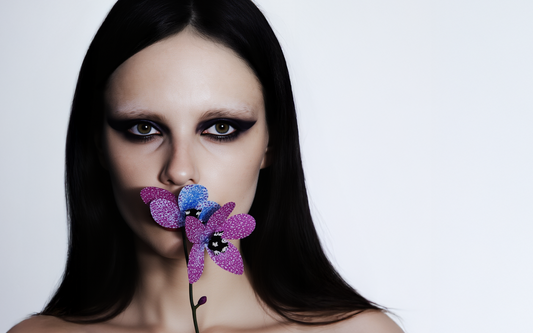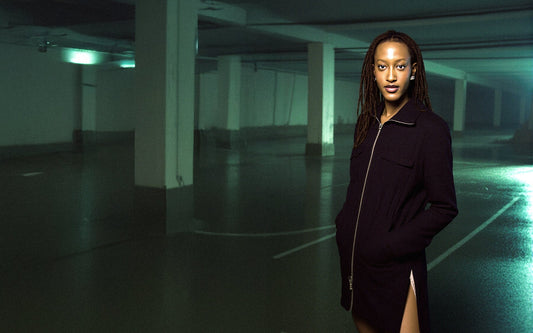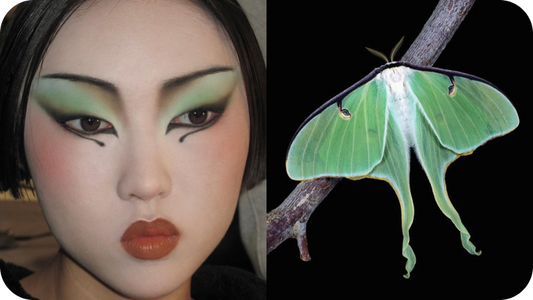Independent curator and writer, Günseli Yalcinkaya, sat down with Paris-based photographer and director, Gil Anselmi, to explore the evolving relationship between AI and image-making, the aesthetics of algorithmic beauty, and what it means to maintain artistic authorship in an increasingly automated world.
A graduate of Les Gobelins and a rising voice in fashion photography, Anselmi is known for her surreal, high-gloss visual language, a style that blurs the boundaries between the cinematic and the uncanny. With her work appearing in the likes of Dazed Beauty, Highsnobiety, Exhibition, and L’Officiel, she continues to expand the visual lexicon of contemporary beauty through a blend of analog craft and digital experimentation.

Credit: FaceValue Experience by STUDIO HALIA and Gil Anselmi
In this conversation, Yalcinkaya, whose editorial lens often interrogates the cultural tensions between technology and aesthetics, joins Anselmi to unpack their collaboration for FACE VALUE, an AI portrait experience developed with STUDIO HALIA. Together, they discuss the illusion of simplicity behind generative tools, the cultural consequences of "AI face," and why embracing the surreal may be one of the last acts of visual rebellion.
Everyone is talking about AI right now. Everyone wants to create an AI and make their own campaign using AI, and so on. It’s a really particular aesthetic and doesn’t necessarily fit into every brand’s direction. This is the game that we’re all going to play for the next few months. But the world is really cyclical, and after every major technological hype, we retreat into something that’s a bit more human, more artisanal.
-
GY: What's your attitude towards AI, what’s your experience been of it so far?
GA: I first made a series using AI in 2022 for Dazed Beauty. I was working with a make-up artist who was using AI for every image that she couldn't find in a mood board, just to bring her ideas alive, and I was doing the same. When we figured out that we were both doing the same thing, we said, why don't we do a project using AI? At that moment, it was still a little weird. Nobody in our industry was doing stuff using AI.
I think it's because most people think that AI is really complicated, but, for instance, Midjourney is very easy to use. I know there are so many different ways of doing AI, some are very difficult, some are quite easy. For me, I'm a geek, so I've never been afraid to play with new technologies or applications.
Both of us knew that it would become mainstream, since AI is going so fast, so we knew that we only had a little time to complete the project. What I would say is that as a photographer, I was concerned about the rights for using images that I hadn’t created myself, so it made me want to train an AI using my own images, which is what we did.
GY: How did that shape your attitude towards AI in general?
GA: The process was very intuitive, but still my major concern right now is how fast AI is developing. As a photographer, or any creative in fact, we have a responsibility over the images that you’re generating, so we have to be very careful. It’s great as a creative tool, but shouldn't be seen as an end in itself. I see working with AI as being in conversation with the software. People think it’s a simple process but it’s not, it takes a long time to really have something that you want to show and that is coherent.

Gil Anselmi X Exhibition Magazine
GY: I think that’s a big misconception around generative AI, that you put in a text prompt and use the first image that is spat out. You really have to work together with the technology and that can take hours, days even.
GA: Using AI for the first time can really feel magical, seeing an image come out of the machine in a matter of seconds. My work itself has never been about reality, and AI allows me to play with the unknown. Also I don’t think a lot of people know when my work uses AI or not, because it’s always had a strange element, which AI really brings out.
GY: You’ve already mentioned using AI for moodboards, what other techniques do you use?
GA: Now I’ve started to use it as a video tool. I'm using a lot of AI on Photoshop as well, since most of my job involves retouching, which makes the process so much easier.

Credit: FaceValue Experience by STUDIO HALIA and Gil Anselmi
GY: That leads us nicely to your collaboration with STUDIO HALIA. What was the process like?
GA: When STUDIO HALIA first approached me, I immediately began to think about applications like TikTok and Capcut, which are shaping popular culture right now. Also social media filters, the ones that transform you into different characters or versions of yourself. I wanted to use the opportunity to push the exploration of identity and beauty through AI even further. We are an image generation, there’s images everywhere, it’s really crazy. So, I wanted to play with this idea and see how we could engineer an individual’s dream version of themselves, and push the boundaries of beauty in the process.
GY: Can you expand on the relationship between AI and beauty standards?
GA: Do you remember back when we were children, our parents would say be careful what pictures you put online? We had no idea they would be used to train an AI one day. We post upgraded pictures of ourselves online, whether that’s using filters, angles or retouching. Consciously or not, we are trying to match beauty standards, which the AI then uses to inform its models. Because of this, AI beauty standards are still very normative. I wanted to push these beauty standards in a similar way to the make-up artist Isamayah Ffrench. I admire how she’s pushing the boundary of beauty and seeking to capture the tenderness of the bizarre. That is something that I want to do and can easily capture using AI.

Credit: Gil Anslemi X Lisa Michalik
Beauty is a bit like when you’re looking at a horror film, a good one...the most scary part of a movie is when you don't really understand what's happening... You just have this emotion, it's an atmosphere, a vibe. When your imagination comes in and your mind is playing tricks on you. I found the same thing with beauty, where there is strangeness
GY: What is it about finding beauty in the bizarre that you’re drawn to?
GA: Beauty is a bit like when you’re looking at a horror film, a good one. I'm not talking about the ones with blood everywhere, I think the most scary part of a movie is when you don't really understand what's happening, when you don't really see what's going on. You just have this emotion, it's an atmosphere, a vibe. When your imagination comes in and your mind is playing tricks on you. I found the same thing with beauty, where there is strangeness and my brain doesn’t really understand what’s going on.

Credit: Gil Anselmi
GY: What are some misconceptions around AI that might be important to consider?
GA: I have very mixed feelings, because AI is moving so fast that everything I’m saying right now might be irrelevant in two weeks. Two years ago, I would’ve said it was a brilliant tool, but now, I have my concerns. Nowadays, my eye is trained to see what’s an AI image or not, so you really start to see it everywhere. That said, I’m not concerned about AI and creativity, because it does give images this very homogenous look that can look a little basic, too hyperreal. What does worry me is everything around that, for instance, corporate photography and commercials, things like that. For me, it’s the loss of authenticity that frightens me, this is why I want to find beauty in the weirdness, because everyone is now doing the same thing.
GY: Do you think we’ll see the rise of AI face, similar to how Instagram face became a thing?
GA: Yes, 100%. My main concern is both the loss of authenticity, but also technological dependency, like relying on AI too might reduce an artist’s creativity. Think of the TikTok effect, or using Chat GPT too much. These systems are so easy and useful, but you do end up using your brain less at the end of the day. I do also think of the ecological impact of using these technologies, it’s a disaster. The amount of energy that Chat GPT uses over silly things is crazy. The world we’re living in right now is so contradictory, because every action has a big impact on the world. As artists, we have a responsibility over our creations. I’m not saying that I’m perfect, but it’s something that we have to be conscious of.

Credit: Gil Anselmi X miu miu
GY: Do you have any future AI trend predictions, what’s next?
GA: Everyone is talking about AI right now. Everyone wants to create an AI and make their own campaign using AI, and so on. It’s a really particular aesthetic and doesn’t necessarily fit into every brand’s direction. This is the game that we’re all going to play for the next few months. But the world is really cyclical, and after every major technological hype, we retreat into something that’s a bit more human, more artisanal.
-
Günseli Yalcinkaya is an independent curator, writer and editor with a particular focus on emerging technologies and internet culture. She is a Contributing Editor at Dazed Magazine, and a contributor at 032c, Art Review and Spike Art. You can follow her work here.
 Log in
Log in



